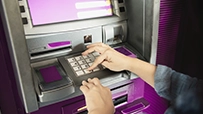What is CVV Code in Debit Card and How to Find It?
August 06, 2025

In today’s digital age, online transactions have become a part of our daily lives. Whether it’s ordering your favourite meal, booking a vacation, or paying utility bills, the convenience of using debit and credit cards is unmatched. But have you ever wondered how your card details remain secure during these transactions? The answer lies in a small but mighty feature known as the CVV. This three or four-digit number acts as a gatekeeper, ensuring your financial information stays safe from potential fraudsters. Let’s dive deeper into what CVV is, where to find it, and why it’s so essential for secure transactions.
This article delves into what CVV means, its importance, and its role in enhancing transaction security.
CVV Full Form and Meaning
The full form of CVV is Card Verification Value. The CVV number is a three-digit number or code that acts as an additional layer of security for your debit and credit card transactions. Note that when we say three-digit, we’re talking about VISA, MasterCard, Discover and RuPay Debit Cards. The CVV code is printed at the back of these Debit Cards. However, if you have an American Express Credit Card, you will find a 4-digit CVV code right at the front of the card. The CVV code ensures that only the person in possession of the card can use it, particularly for online transactions.
The CVV number is unique to every card and is generated using the card’s primary account number, expiration date, and a secure algorithm. While the specifics of its generation remain confidential for security reasons, its purpose is straightforward: to protect cardholders from unauthorized usage.
Where Can You Find the CVV Number?
The location of the CVV varies based on the type of card:
- Debit Cards: Typically found on the back of the card, next to the magnetic stripe. It is a three-digit number.
Credit Cards:
- VISA and MasterCard: A three-digit number located on the back, above the signature strip.
- American Express: A four-digit number on the front of the card, above the account number.
CVV in Debit Card vs. PIN
While both CVV and PIN (Personal Identification Number) enhance security, they serve different purposes:
| Feature | CVV Number | PIN |
| Purpose | For online transactions | For ATM withdrawals and POS payments |
| Location | Printed on the card | Not printed; memorised by the user |
| Changeability | Permanent, linked to the card | Can be changed by the user |
How CVV Protects Your Transactions
1. Online Transactions:
- The CVV acts as a verification step to ensure that the transaction is initiated by the cardholder.
- For online purchases, you need to enter the CVV number, along with your card details and OTP (One-Time Password).
2. Prevents Data Breaches:
Merchants are prohibited from storing CVV numbers, even if they save your card details. This ensures that your CVV remains secure even if the merchant’s database is compromised.
3. Enhances Security:
- The CVV is not encoded on the magnetic stripe, making it impossible to replicate during a skimming attack.
What are CVV2 Numbers?
You may have come across the term “CVV2” while reading about card security. CVV2 refers to the second-generation Card Verification Value. It serves the same purpose as the original CVV but is specifically used for online and card-not-present transactions. The distinction lies in its enhanced security algorithms.
Why Is the CVV Confidential?
The CVV number is a critical component of card security and should always remain confidential. Here are some key reasons:
- Sharing your CVV with others can lead to unauthorized transactions.
- Scammers may use phishing techniques to obtain your CVV. Always verify the authenticity of requests for card details.
- Banks and financial institutions never ask for your CVV over calls, emails, or messages.
Tips to Protect Your CVV
- Avoid Public Wi-Fi: Use a secure internet connection for online transactions.
- Use Trusted Websites: Only shop on websites with HTTPS and a padlock symbol in the address bar.
- Enable Alerts: Activate transaction notifications to monitor card usage.
- Install Antivirus Software: Protect your devices from malware and phishing attacks.
- Avoid Sharing Card Details: Do not share photos or write down your card information, including the CVV.
- Beware of Phishing Scams: Be cautious of unsolicited emails or messages asking for your card details.
Common Misconceptions About CVV
- CVV is the same as the card PIN: This is incorrect. CVV is for online verification, while PIN is for physical transactions and ATM usage.
- CVV can be changed: Unlike PINs, CVVs are permanent and tied to the card.
- CVV is stored by merchants: Reputable merchants cannot legally store CVV numbers after a transaction.
Final Thoughts
The CVV code in your ATM or debit card is a vital security feature designed to protect cardholders during online transactions. By understanding its importance and following best practices, you can ensure safe and secure use of your debit and credit cards. Always remember, safeguarding your CVV is a key step in protecting your financial information.
Enjoy easy banking with Ujjivan Small Finance Bank. Save more with our high-interest Savings Account and Deposit products. Need cash for your business or personal needs? Apply for MSME Loans or Micro Loans with us – we offer competitive rates and quick disbursal. We also offer vehicle loans and home loans tailored for your unique requirements. Experience a smooth banking journey with Ujjivan SFB!
Disclaimer:
The contents herein are only for informational purposes and generic in nature. The content does not amount to an offer, invitation or solicitation of any kind to buy or sell, and are not intended to create any legal rights or obligations. This information is subject to updation, completion, amendment and verification without notice. The contents herein are also subject to other product-specific terms and conditions, as well as any applicable third-party terms and conditions, for which Ujjivan Small Finance Bank assumes no responsibility or liability.
Nothing contained herein is intended to constitute financial, investment, legal, tax, or any other professional advice or opinion. Please obtain professional advice before making investment or any other decisions. Any investment decisions that may be made by the you shall be at your own sole discretion, independent analysis and evaluation of the risks involved. The use of any information set out in this document is entirely at the user’s own risk. Ujjivan Small Finance Bank Limited makes no representation or warranty, express or implied, as to the accuracy and completeness for any information herein. The Bank disclaims any and all liability for any loss or damage (direct, indirect, consequential, or otherwise) incurred by you due to use of or due to investment, product application decisions made by you on the basis of the contents herein. While the information is prepared in good faith from sources deemed reliable (including public sources), the Bank disclaims any liability with respect to accuracy of information or any error or omission or any loss or damage incurred by anyone in reliance on the contents herein, in any manner whatsoever.
To know more about Ujjivan Small Finance Bank Products Visit:"https://www.ujjivansfb.in"
All intellectual property rights, including copyrights, trademarks, and other proprietary rights, pertaining to the content and materials displayed herein, belong
to Ujjivan Small Finance Bank Limited or its licensors. Unauthorised use or misuse of any intellectual property, or other content displayed herein is strictly prohibited and the same is not intended for distribution to, or use by, any person in any jurisdiction where such distribution or use would (by reason of that person’s nationality, residence or otherwise) be contrary to law or registration or would subject Ujjivan Small Finance Bank Limited or its affiliates to any licensing or registration requirements.
FAQs
1. What is the full form of CVV?
CVV stands for Card Verification Value. It is a security feature on debit and credit cards.
2. Where is the CVV number in a debit card?
The CVV number is located on the back of the card, next to the magnetic stripe.
3. What is the difference between CVV and CVV2?
CVV2 is an updated version of CVV, designed for online and card-not-present transactions with enhanced algorithms.
4. Can a CVV number be changed?
No, the CVV is permanently linked to the card and cannot be changed unless the card is replaced.
5. Why is CVV important for online transactions?
CVV verifies that the transaction is initiated by the cardholder, adding a layer of security.
6. Can merchants store my CVV number?
No, merchants are legally prohibited from storing CVV numbers after a transaction.
7. Is CVV used for ATM transactions?
No, ATM transactions require a PIN, not a CVV.
8. What happens if someone knows my CVV?
If someone has your CVV and card details, they can perform unauthorized online transactions. Always keep your CVV confidential.
9. What is CVV in an ATM card?
CVV in an ATM card refers to the three-digit number on the back, used for online transactions.
10. How is a CVV generated?
CVV is generated using the card’s account number, expiration date, and a secure algorithm, ensuring its uniqueness and security.
Latest Blogs

How Recurring Deposits Help You Build a Savings Habit
June 24, 2025
Saving money sounds easy, until you try to do it every month. Life keeps throwing expenses at you, and before you know it, the idea of saving becomes a “next month” plan.

What Makes Agriculture Loans Different from Regular Credit Lines
June 26, 2025
At first glance, all loans may look the same. They provide money when you need it and expect repayment with interest.

How Pisciculture Loans Help Boost India’s Blue Economy
June 26, 2025
India’s economic future doesn’t lie only in its cities or industries—it also flows through its rivers, lakes, and coastline.

New UPI Rules Effective August 1, 2025: What Every User Needs to Know
May 13, 2025
Starting August 1, 2025, major updates to UPI (Unified Payments Interface) usage rules will come into effect across all apps and banks.

How Ujjivan’s High-Interest Savings Accounts are Breaking Traditional Banking Norms
June 25, 2025
Savings accounts have long been seen as the safest place to keep money you’re not using, right away.




